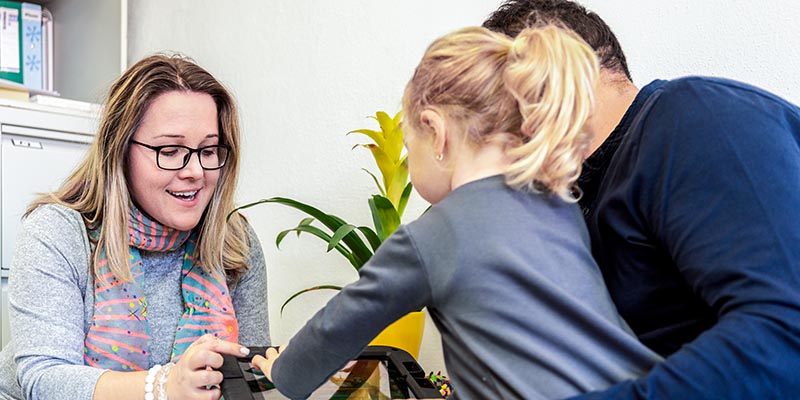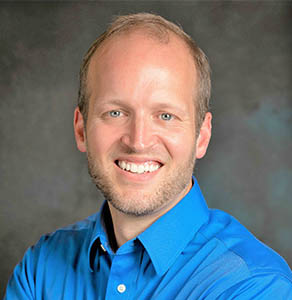
Research creates insight for safety-net programs to disrupt generational poverty
“We are committed to using business to create positive impact and a better world. So, how can we build on decades of understanding consumers and services to do that?” asks College of Business researcher Chris Blocker.
His research blends insights from marketing, social services and family studies to examine how support services and cities can apply a consumer-marketing lens to social services to create value for communities and help families flourish. Published in the Journal of Business Research, the marketing department’s Blocker joins California State University, Los Angeles’ Shikha Upadhyaya and Rika Houston, as well as Ascend at the Aspen Institute’s Marjorie Sim, to investigate consumer needs and service strategy in what are called two-generation services.
This service model bucks the norm of most social services by practicing a holistic view of family needs that combine parent and child programs to more effectively disrupt hidden cycles of poverty. In contrast, conventional models aim to address individual needs, for example, offering early child education for kids or job help for adults.
Speaking from the perspective of business and marketing, Blocker and his coauthors contend that two-generation social programs are better equipped to create long-term positive impacts than the prevailing system. Their validation of the two-generation approach adds its voice to a growing chorus of social service leaders who are calling for an overhaul of the American safety net to adopt two-generation principles.
A challenge preventing holistic service models from widespread adoption is that they are far more complex and require integration. This broad view goes against the grain of the prevailing single-service approach of conventional social service providers. To help address these problems, Blocker examines how network of non-profits, for-profit businesses and governmental agencies can bolster their missions to address the unmet needs of families using insights from marketing service strategies.
“Emerging concept of journey mapping from the world of consumer research can be a particularly powerful tool for designing and delivering social services,” Blocker said. “We’re beginning to better understand consumer journeys, like the journey of a service experience that unfolds across time and interactions with other people.”

Historically, marketing and consumer research have highlighted ways to create value for consumers inside a single purchase and at a single point in time. However, translating insights from everyday services like a restaurant experience or car maintenance to the long-term goals of social-work agencies requires marketers to rethink their perspectives.
“We now need to think even bigger, broader and deeper about life projects and journeys,” Blocker said. “In the case of social services, we know a lot less about how to create value for low-income families who need ‘sticky’ and innovative services to reach their life and family goals.”
Disrupting cycles of generational poverty
Two-generation service providers focus on building integrated programs that address the dynamic and interconnected relational needs of low-income families to promote child and family wellbeing. Marketing’s consumer journey mapping tool is well suited to address this type of social service design. The challenge? Journey mapping may be at odds with the current model of individual services that currently solve one piece of a problem for one person at a time – not families.
“The current state of social services and their ecosystems need a major overhaul. Two-generation services are a real bright spot, but to be honest, they are still quite rare,” Blocker said.

Blocker and his coauthors seek to amplify the adoption of the two-generation service model by addressing barriers for its success. To do so, they first analyzed qualitative data across three cities from participants whose income is 200 percent below the federal poverty line. The analysis leveraged two theories that have not yet been combined – family systems theory and service dominant logic.
Family systems examines how high functioning families respond to stress and explains how families flourish as they achieve greater flexibility and cohesiveness. It studies how families do well when they operate within the sweet spots found between chaos versus rigidity and smothering versus disengagement. Service dominant logic explains the way that resources are created, shared and integrated within markets, customer networks such as friend groups or families, and institutions such as organizations that make up a safety net within a city.
When blended, these two theories spark innovative and transformative ideas for social service design. For example, the research analysis of family needs using family systems and service dominant perspectives identifies the need to focus on family-level storytelling, use digital platforms for social feedback and equip social work leaders with journey mapping tools and resources. To go beyond improving existing services such as a job readiness class for a parent, social service leaders might work with families to create compelling visuals that clarify family-level needs, spark ambition for achieving goals together and offer a roadmap with milestones for long-term success.
“Using infographics or digital resources to depict a consumer journey is becoming more prevalent in the everyday consumer marketplace,” Blocker said. “However, co-creating a visual journey with participants, to discuss how, ‘You’re right here in the journey, and let’s imagine together what the next steps are,’ can be transformational.”
Helping families progress along a journey requires more than a roadmap. Blocker and his coauthors’ advocate applying contemporary market-based tools such as ethnographic research, experiments and marketing analytics within social welfare programs.
Knowing that consumers are more responsive to engaging messaging, the research encourages two-generation service providers to draw upon the same kinds of marketing tools that businesses use to spark emotional connections with products, brands and experiences to tell stories of self-sufficiency.
“How can we leverage the best tools we have available to facilitate paths for families to build their resilience, expand their resources, and share stories about their progress?” Blocker asked.
Capacity building for collective family wellbeing
Blocker and his coauthors’ paper joins decades of research that indicates the customer-centric model proposed by two-generation providers is more effective at lifting people out of poverty. That approach is rarely adopted and often mired in the difficulty of departing from the traditional approaches social service providers take. For myriad reasons that include funding models, limited resources, and providers’ single participant structures, decades of support infrastructure have been built to address narrow needs.
“For 20 years, social-services thought leaders, providers and researchers have been trying to move out of the traditional model adopt more integrated approaches,” Blocker said.
The team’s Journal of Business Research article builds on service conducted by Ascend within the Aspen Institute, lends fresh perspectives to the champions of two-generation support services and advocates for a more comprehensive approach to safety nets. The research and practical ideas offer pathways for helping social services and the network of support within cities develop more flexible and connected service ecosystems, Blocker said.
“To break through to a whole new level of helping families flourish, we must think more deeply about the well-known ‘triple bottom line’ that measures true success by people, planet, and profit,” he said. What we’re finding is that, in social services we need to activate all the powerful levers in the business and marketing skill set, our analytics, our theories, our methods to play our part in using business to create a better world.”